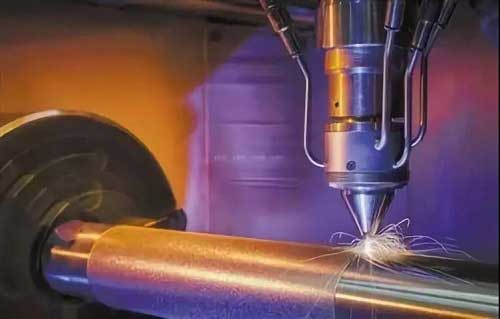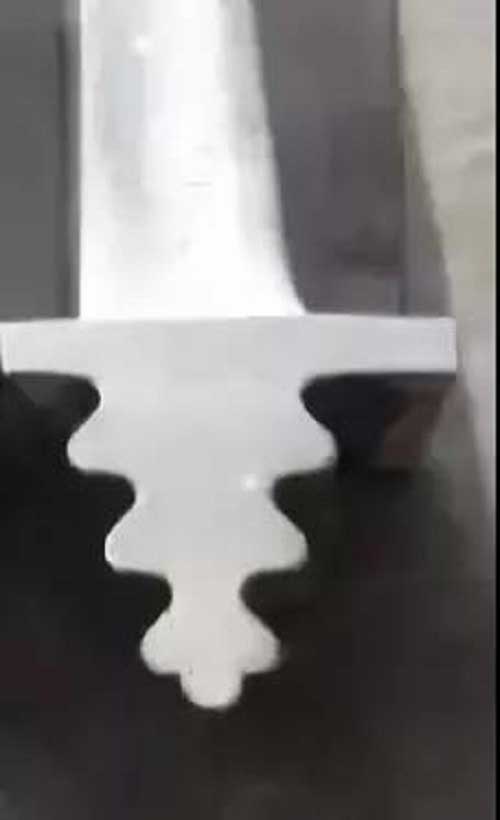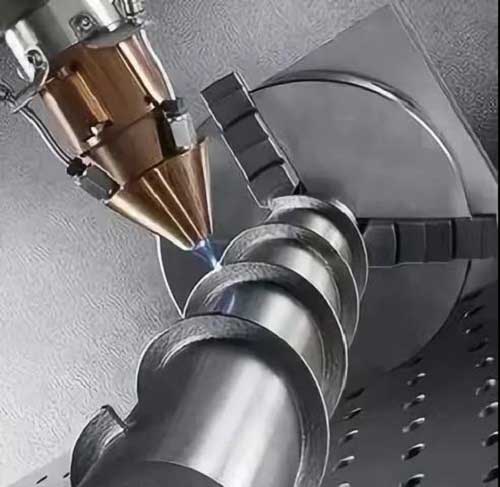Application analysis of laser cladding technology in parts repair (HY-marketing department)
-
With the continuous development of modern science and technology and industry, the working environment of parts is becoming more and more complicated, and the requirements for surface performance are getting higher and higher, so the scrap rate of parts is greatly increased. The parts that are usually scrapped due to surface failure are: rotor blades, roller parts, gear parts, joint parts, etc.
-
 Under the condition that the overall performance of the parts meets the working conditions, the parts that are only damaged on the surface can be repaired. If the parts that are scrapped due to misprocessing or service damage can be repaired, not only can the huge economic and time loss be restored, but also the utilization rate of resources can be improved, which is in line with my country’s sustainable development strategy.
Under the condition that the overall performance of the parts meets the working conditions, the parts that are only damaged on the surface can be repaired. If the parts that are scrapped due to misprocessing or service damage can be repaired, not only can the huge economic and time loss be restored, but also the utilization rate of resources can be improved, which is in line with my country’s sustainable development strategy. -
At present, the methods of repairing parts include laser cladding, vacuum brazing, vacuum coating, tungsten inert gas welding (TIG) and plasma cladding repair. Laser cladding is based on the working conditions of the workpiece, cladding metals or non-metals of various design compositions to prepare surface coatings with heat resistance, corrosion resistance, wear resistance, oxidation resistance, fatigue resistance or optical, electrical, and magnetic properties. . Laser cladding is a rapid cooling process. During the cladding process, the heat input to the repaired workpiece is small, the heat-affected zone is small, the cladding layer structure is small, and it is easy to realize automation. Therefore, the laser cladding method is used to repair the rotor Equal parts have greater advantages than other methods. Laser cladding technology solves a series of technical problems such as thermal deformation and thermal fatigue damage that are inevitable in thermal processing such as traditional electric welding and argon arc welding. It also solves the bonding strength of coating and substrate during cold processing such as traditional electroplating and spraying. Poor contradiction, which provides a good way for surface repair.
-
This article reviews the application of laser cladding technology in surface repair, summarizes the research and development of laser repair technology in different parts and different failure situations at home and abroad, and prospects the application prospects of laser cladding in surface repair.
1 Repair of rotor blades
-
Rotor blades, also known as moving blades, are blades that rotate with the rotor at high speed. The high-speed rotation of the blades realizes the energy conversion between the airflow and the rotor. The rotor blades bear large mass inertia force, large aerodynamic force and vibration load, and also bear the corrosion and oxidation of environmental media, as well as the erosion of small particles in high-speed operation, but the processing is more difficult, and the turbine rotor blades must be exposed to high temperatures. Work in the state. The rotor blade is a key part that directly affects the performance, reliability and life of the engine, and its working conditions are very bad and easy to be damaged. Therefore, the requirements for material performance are greatly improved, and the economic cost of the material is increased, and repair belts are also used for it. Come to the vast market. The application of laser cladding technology on rotor blades has been well studied, which also provides a favorable prerequisite for its application in repair.
1.1 Repair of aero engine blades
-
At present, most aero-engine blades are made of cast nickel-based superalloys and directionally solidified nickel-based superalloys. Cast nickel-based high temperature blades and directional solidification blades may have local defects during the production process, such as shrinkage porosity, shrinkage cavities and other casting defects.
-
Laser cladding has the advantages of local heating and low heat input. At the same time, the ultra-high temperature gradient of laser cladding is conducive to the directional solidification growth of materials. Therefore, extensive research has been carried out on the repair of high value-added blades with laser cladding technology at home and abroad, and it has been successfully applied in industry. At the same time, the laser cladding technology is compared with surfacing welding, TIG welding and plasma cladding. The research work of David W. Gandy et al. pointed out that under optimized laser process conditions, the laser cladding layer-by-layer deposition of IN-939 on the IN-738 substrate was achieved, and a good quality deposited layer was obtained. The Fraumhofer ILT Institute in Germany performed laser repair on Ti-6Al-4V and Ti-17 blades and achieved success. L. Sexton et al. used Inconel 625 and Rene 142 nickel-based superalloys to repair blades by laser cladding, and pointed out that the laser cladding layer has a smaller heat affected zone and dilution rate than TIG coating, good microstructure, Hardness and low porosity. L. Shepeleva et al. compared the advantages and disadvantages of the blade laser cladding layer and plasma cladding layer through experiments, and pointed out that the laser cladding layer has higher hardness than the plasma cladding layer, without cracks and pores, and has a good bonding interface. In 1981, Rolls-Royce Company interlocked the high-pressure blades of the RB211 aircraft engine. GE has used laser cladding technology for the repair of nickel-based superalloy blades of aero-engines, and it has achieved good results.
1.2 Repair of steam turbine blades
-
Steam turbine blades transform the linear motion of high-temperature and high-pressure gas into the rotation of the steam turbine shaft in the power industry. There are two main forms of failure of steam turbine blades: one is blade fracture, which mainly occurs at the root of the blade, and this failure is irreparable; the other type of failure is cavitation, which mainly occurs at the top surface or root of the blade. Blades damaged by cavitation can be repaired and reused.
-
Application of laser cladding in the repair of hot-end parts of gas turbines should be the first to promote GE. The company used 5kw CO2 laser processing to repair the tip of high-pressure turbine blades in 1990, and is called the company’s top ten new ones. One of the technologies. Later, Liburdi Engineering Limited in the United States also researched and developed a highly automated laser cladding system for the repair of the tip and crown of the rotor blade of the JT8D engine. The German Motor and Gas Turbine Union (MTU) Maintenance Company and the Hannover Laser Research Center have developed laser cladding surfacing technology for hard coating or restoring geometric dimensions of the resistance surface of the turbine blade crown. The Westinghouse Company of the United States used this technology to repair the water erosion at the front end of the 1.2m long steam engine blade. Pratt & Whitney used a 6kW laser to successfully cladding cobalt-based alloys on nickel-based alloy steam turbine blades. At the logistics maintenance center at Tinker Air Force Base in Oklahoma, approximately 1,200 engines are overhauled each year, and blade repair alone can generate several billion dollars in benefits each year.
-
 Domestic steam turbine blade repair technology has also been greatly developed in the past ten years. From the deployment of the process to the choice of cladding materials, great progress has been made. For example, Lanzhou University of Technology has been researching laser cladding repair materials for many years, and has achieved certain results in this field, and has cooperated with Lanzhou Great Wall Machinery Factory to research the laser cladding repair technology of flue gas turbine blades and other parts, and achieved In order to successfully put into production on a large scale. Figure 1 shows the comparison of blades before and after repair
Domestic steam turbine blade repair technology has also been greatly developed in the past ten years. From the deployment of the process to the choice of cladding materials, great progress has been made. For example, Lanzhou University of Technology has been researching laser cladding repair materials for many years, and has achieved certain results in this field, and has cooperated with Lanzhou Great Wall Machinery Factory to research the laser cladding repair technology of flue gas turbine blades and other parts, and achieved In order to successfully put into production on a large scale. Figure 1 shows the comparison of blades before and after repair
2 Repair of roller parts
-
Roller is a tool for plastic deformation of (rolled material) metal, and it is an important large-scale consumable part that determines the efficiency of the rolling mill and the quality of the rolled material. The most common cause of roll failure is early wear failure. At present, when rolls need to be repaired due to wear and tear, “remedial measures” such as turning or grinding are often used to correct the roll shape. The use of laser cladding to repair the surface of the roll has become a major development direction and approach to extend the life of the roll [18]. This technology can not only repair the roll, but also improve the wear resistance of the roll, prolong the service life of the roll, and improve the surface quality of the steel.
-
Generally, the main reasons for the failure of shaft parts are shaft deformation, shaft fracture, and shaft surface failure. Studies have shown that the damage to shaft parts such as generator shafts and various drive shafts is mainly due to wear. Among them, shaft deformation and shaft fracture cannot be repaired, while surface failures mainly caused by wear can be repaired. Using high-power laser cladding repair technology, a layer of iron-based alloy material can be laser cladding on the failure part of the shaft part surface, so that the surface of the part with the cladding alloy layer has good mechanical properties, and the scrapped parts can be reused.
-
Lu Wei and Yao Ningjuan of Beijing University of Technology performed laser cladding of Co-WC cobalt-based alloys on high-speed wire rolls and hot rolls. Coated with NiCrSiBC nickel-based alloy, and through on-site rolling life evaluation experiments, calculated according to the amount of wear, the life of the laser cladding roller is 25.7%-37.4% longer than that of the roller without laser treatment. Now in China, it is possible to repair shaft parts such as high-speed air compressor rotors, crankshaft cracks of large reciprocating compressors, pump shafts, screw compressor rotors and so on. The laser cladding technology was used to repair the fan shaft of the Liugang Sintering Plant, the main shaft of the jaw hydraulic protection crusher, the motor rotor of the Liugang converter plant, and the shaft of SAIC-GM-Wuling. The performance of the repaired shaft reached even Exceeding the original effect, the use condition is good.
3 Repair of molds
-
Molds play an important role in casting molding and plastic molding processing. The manufacturing process is complicated, the production cycle is long, and the processing cost is high. Therefore, repairing and reusing failed molds will undoubtedly have significant economic benefits. The service life of the mold depends on the ability to resist wear and mechanical damage. Once excessive wear or mechanical damage, it must be repaired before it can be used again. Laser cladding has become a research hotspot in repairing molds and has attracted the attention of scholars at home and abroad.
-
The method of laser cladding to repair the surface wear of the mold can be summarized as follows: a high-power laser beam is incident on the mold surface with a constant power P and a flow of hot powder at the same time. After the absorbed energy exceeds the critical value, the metal melts to produce a molten pool, which then rapidly solidifies to form a metallurgical bonded coating. The laser beam scans back and forth to repair the mold line by line and layer by layer according to the route given by the CAD secondary development application. In particular, the repaired mold hardly needs to be processed again.
4 Repair of other parts
-
During the use of the valve, its sealing surface has been in the medium for a long time and is eroded and corroded by the medium. Using laser cladding process instead of plasma spraying and vacuum induction welding process, cladding NiCrBSi and CoCrW alloy coating on the sealing surface of internal combustion engine exhaust valve not only avoids the holes and micro-cracks in the coating, but also the microscopy of the coating The hardness is obviously improved, and the wear resistance and corrosion resistance of the sealing surface of the exhaust valve are increased by 3 to 4 times.
-
The medium-pressure steam chamber nozzles and part of the partition nozzles of the steam turbine are more severely eroded by the steam medium. Among them, the pressure cylinder nozzle withstands a temperature of 350℃, the material is ZG20GrMo, and the average thickness of the exhaust end of the blade is only 0.02mm-0.05mm. The damaged part of the blade is repaired by the general welding method, which is very easy to cause thermal deformation of the substrate and cracks. The laser cladding process was used to repair, and the repaired nozzle met the original design requirements, and the operation effect was good after a period of time.
-
High-speed transmission carburized gear wear tooth surface due to the existence of residual carburized layer, causing great difficulties in tooth surface repair. The material of this type of gear is 20Cr2Ni4A or 18Cr2Ni4WA steel, and the depth of the carburized layer is 1.6~1.9 mm. It was repaired using laser cladding technology. This cladding layer fully meets the requirements for gear repair. After testing, the contact fatigue characteristic life of the laser cladding layer is 15% longer than that of the part carburized layer under the conditions of contact stress of 2170 MPa, slip of 12.5% and No. 20 oil lubrication. This cladding layer fully meets the requirements for gear repair.
-
Flue gas expander (smoke machine for short) is an important device for waste heat power generation in industrial sectors such as oil refineries, and the roulette is a key component of the device. At present, the repair of the hood roulette mainly uses laser cladding repair. The repaired laser cladding layer is formed by a layer-to-layer stacking method, from the bottom layer to the surface layer through the middle layer. The hood wheels of Lanzhou Oil Refinery, Shanghai Oil Refinery and Dalian Oil Refinery are all repaired by laser cladding. Lanzhou University of Technology cooperated with Shanghai HY Inductry Co., Ltd to repair the hood roulette, and successfully put it into production on a large scale, and applied it to TH85-2 and E-232 hood. This has further improved and developed the laser cladding repair system project for the cigarette machine roulette, established a quality assurance system, and better perfected the laser cladding repair technology.
5 Conclusion
-
 Laser cladding technology has a wide range of engineering requirements for the repair of high manufacturing technology requirements, long production cycles, high processing costs, and expensive engineering components. At the same time, it can optimize resource allocation, save precious and rare metal materials, reduce energy consumption, and save money. . The laser cladding repair technology is pollution-free and pollution-free, and has a strong role in protecting the environment, and belongs to the green remanufacturing project. From a long-term perspective, laser cladding technology will play an important role in precision repair with its unique advantages.
Laser cladding technology has a wide range of engineering requirements for the repair of high manufacturing technology requirements, long production cycles, high processing costs, and expensive engineering components. At the same time, it can optimize resource allocation, save precious and rare metal materials, reduce energy consumption, and save money. . The laser cladding repair technology is pollution-free and pollution-free, and has a strong role in protecting the environment, and belongs to the green remanufacturing project. From a long-term perspective, laser cladding technology will play an important role in precision repair with its unique advantages. -
Laser cladding technology precision repair parts still need in-depth research and development in the development of laser cladding materials, the optimization of laser process parameters, the automation of the laser cladding process, and the control of the stress field and temperature field in the laser cladding system. Explore.

